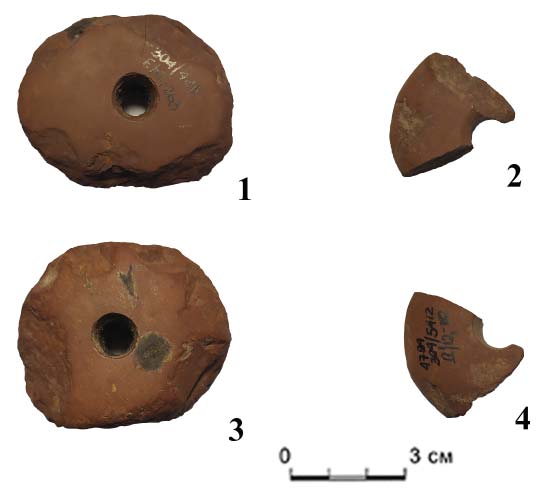THE GRINDED DISCS OF THE MIDDLE URALS: TECHNOLOGY, FUNCTION, INTERPRETATION
DOI:
https://doi.org/10.24852/2587-6112.2021.5.328.334Keywords:
archaeology, historiography, stone inventory, Trans-Urals, grinded discs, Neolithic, Eneolithic, Bronze Age, typology, technologyAbstract
Grinded disks represent a category of artefacts widely spread across a vast territory from East Baltics and Scandinavia to Far East. The disks from the collections of the Middle Trans-Ural sites feature a significant variety. However, the research literature lacks a formed typology of this category of artifacts. The understanding of their production technology is also scarce. As a result of the analysis of the historiography of the issue, the paper lists most of the known grinded disks of the Trans-Urals and presents a typology of these artifacts. The issue of the relationship between the shape of the products and their functions is reviewed. Despite the small sample, statistical methods were applied using the STAGRAPHICS Plus software package. In addition, two discs from the collection of the Lipchinsky settlement, which are interpreted as sinkers, were introduced into scientific discourse.
References
Galimova, M. Sh. 2010. In Uchenye zapiski Kazanskogo universiteta. Ser. Gumanitarnye nauki (Scientific Bulletin of the Kazan University. Series: Humanities) 152. Book 3–1, 63–73 (in Russian).
Grekhov, S. V. 2020. In Mingaleva, M. K. (ed.). LII Uralo-Povolzhskaya arkheologicheskaya studencheskaya konferentsiya (UPASK, 5-8 fevralya 2020 goda): materialy vserossiyskoy (s mezhdunarodnym uchastiem) konferentsii studentov, aspirantov i molodykh uchenykh (52nd Ural-Volga Archaeological Student Conference (UPASK, February 5–8, 2020): Proceedings of the All-Russian (with International Participation) Conference of Students, Postgraduates and Young Scientists). Perm: Perm State University, 95–97 (in Russian).
Zhilin, M. G., Savchenko, S. N., Kosinskaya, L. L., Serikov, Yu. B., Aleksandrovsky, A. L., Lapteva, E. G., Korona, O. M., Kosintsev, P. A. 2020. Mezoliticheskie pamiatniki Gorbunovskogo torfianika (Mesolithic Monuments of Gorbunovsky Peatbog). Moscow; Saint Petersburg: “Nestor-Istoriia” Publ. (in Russian).
Zubkov, V. S. 2010. In Izvestiya Laboratorii drevnikh tekhnologiy: sbornik nauchnykh trudov (Review of the Laboratory of ancient technologies: a collection of scientific papers) 8 (1), 215–220 (in Russian).
Kerner, V. F., Nesterova, G. M., Ivanov, O. K. 2003. In Ural'skii geologicheskii zhurnal (Ural Geological Journal) 2, 113–134 (in Russian).
In Oshibkina, S. V. (ed.). 1996. Neolit Severnoi Evrazii The (The Neolithic of Northern Eurasia). Series: Arkheologiia SSSR (Archaeology of the USSR). Moscow: “Nauka” Publ.(in Russian).
Chairkina, N. M. 2005. Eneolit Srednego Zaural'ia (The Eneolithic of the Middle Urals). Ekaterinburg: Ural Branch of the Russian Academy of Sciences (in Russian).
Savchenko, S. N., Zhilin, M. G. 2016. In Rossiiskaia Arkheologiia (Russian Archaeology) (3), 136–151 (in Russian).
Savchenko, S. N., Zhilin, M. G. 2020. In Kratkie soobshcheniia Instituta arkheologii (Brief Communications of the Institute of Archaeology). 259, 86–99 (in Russian).
Serikov, Yu. B. 2011. In Cheliabinskiy gumanitariy (Chelyabinsk Humanitarian) 4, 117–130 (in Russian).
Serikov, Yu. B. 2018. In Povolzhskaya arkheologiya (Volga River Region Archaeology) 23 (1), 56–73 (in Russian).
Sleptsov, I. Yu., Klyuev, N. A., Garkovik, A. V., Goryushin, Yu. A. 2002. In Rossiya i ATR (Russia and Asia–Pacific Region) 3, 88–95 (in Russian).

Downloads
Published
How to Cite
Issue
Section
License
Copyright (c) 2021 Khrantsov Mikhail V.

This work is licensed under a Creative Commons Attribution-NonCommercial 4.0 International License.







